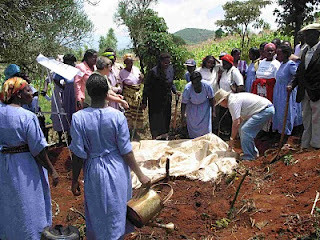
In August, we took samples of the soil farmed by the members of the Muchui Womens Group and the Ruuju Womens Group which sent to the Kenya ministry of Agriculture for analysis.. We found that the land was low in organic matter. This has resulted from growing maize year after year.
So Winston and Susan worked with the women to prepare compost piles on their farms. They prepared a fact sheet listing the steps in preparing a compost pile. They listed the materials that could be used to make a compost. They also included the reasons why compost would improve the level of organic matter and how higher organic matter would improve their crop yields in the future. Also it would reduce the need for purchased fertilizer and would hold moisture in the soil better.
They presented a seminar to both groups of women with a large diagram showing the layers of materials to be put in a compost pile.
Then they went out with the group to make a compost pile on one of their farms. The women had already dug a hole and had assembled the materials they have on their farms to make the piles. There were branches for the bottom. They had green material in the form of tithonia leaves. They had dried bean stalks and corn stover. They had ashes, top soil and manure. They also had water.
Susan jumped in the hole and started to lay the branches in the bottom of the hole. Winston forked in bean vines. But it wasn’t long before all of the women were adding materials under their direction and soon the pile was complete. We stuck a long hard wood stick down into the pile so the women can check to see if it is heating up.
In three weeks the compost should be done. The women have dug three pits so they can turn it as it matures.
We went back to see the pile on Thursday and it was already 140 degrees. We’ll check it again later.
We also saw many women digging pits and assembling materials to build their own compost piles.
No comments:
Post a Comment